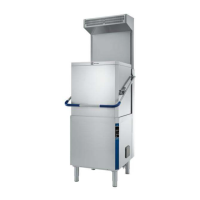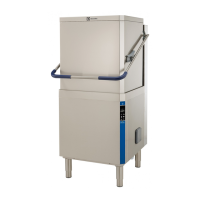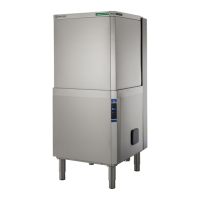38
When using the machine again, follow the indications
in par. J4 “Daily activation of machine”.
J11 Maintenance
Inspection and maintenance intervals depend on the
actual machine operating conditions (total wash hours)
and ambient conditions (presence of dust, damp, etc.),
therefore precise time intervals cannot be given. In any
case, to minimize interruptions of the service, careful
and periodical machine maintenance is advisable.
Therefore, it is advisable to:
• Descale the boiler, inside surfaces of the tank and
the machine piping once or twice a year (call tech-
nical assistance).
• Every month descale the wash and rinse jets with
vinegar or scale remover.
• The internal hose of the rinse-aid and detergent
peristaltic dispenser should undergo periodic main-
tenance (once or twice a year).
• If present, clean the finned coil of the energy saving
device once or twice a year (call technical assis-
tance).
It is also advisable to stipulate a scheduled pre-
ventive maintenance contract with technical assis-
tance.
J11.1 Preventive maintenance
The preventive maintenance call can be activated (call
technical assistance).
On reaching the set number of cycles (e.g. 20000), a
technical assistance call message appears on the dis-
play.
This message suggests calling a specialized techni-
cian, for a general check of the equipment.
J12 Machine disposal
At the end of the product’s life cycle, make sure the
equipment is not dispersed in the environment. The
equipment must be disposed of in compliance with
current regulations in the country of use.
All metal parts are in s/steel (AISI 304) and removable.
Plastic parts are marked with the letters of the material.
The symbol on the product indicates that this
product should not be treated as domestic waste, but
must be correctly disposed of in order to prevent possi-
ble negative consequences for the environment and
the human health.
Regarding the recycling of this product, please contact
the sales agent or dealer of your product, your after-
sales service or the appropriate waste disposal service.
J13 Troubleshooting
DISHWASHER DOES NOT WASH WELL
1. Check if the suction filter is dirty and clean it thoroughly.
2. Check if the wash jets are clogged by solid food
remains.
3. Check that the initial amount of detergent or subse-
quent additions are correct.
4. The selected wash cycle is too short. Repeat the cycle.
5. Check that the tank temperature is at least 55°C /
131°F.
6. Check that the dishes are stacked correctly in the racks.
GLASSES AND DISHES ARE NOT DRIED PROPERLY
1. Check that there is rinse-aid in the container and if nec-
essary top up.
2. Check the set amount of rinse-aid (see “setting the
dispensers” paragraph).
3. Check that the water temperature is between 80°C and
90°C.
CONDENSATION ON GLASSES
1. Check that there is rinse-aid in the container and if nec-
essary top up.
2. Check the set amount of rinse-aid (see “setting the
dispensers” paragraph).
3. Remove the rack of glasses immediately the cycle has
ended.
STAINS ON THE GLASSES
1. Only use “non-foaming” products for professional
dishwashers.
EXCESSIVE FOAM IN THE TANK
1. Check that the wash water temperature is not less than
55°C / 131°F.
2. Check if the amount of product dispensed by the deter-
gent dispenser is excessive (see “setting the dispen-
sers” paragraph).
3. Ensure that the tank has not been cleaned with unsui-
table cleaners. Drain the tank and rinse thoroughly
before new wash cycles.
4. If a foaming detergent has been used, drain and refill
the tank with water until the foam disappears.
SMEARS OR SPOTS ON THE GLASSES
1. Reduce the amount of rinse-aid (see “setting the
dispensers” paragraph).
THE WASH OR RINSE ARMS TURN SLOWLY
1. Remove and thoroughly clean the arms.
2. Clean the wash pump suction filter.

